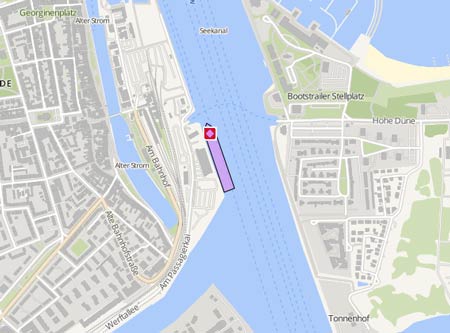MUMBAI MAERSK
Course/Position
Latest ports
Latest Waypoints
Latest news
IÜnvestigation report into grounding on the Weser published
On March 26, 2025, the Federal Bureau of Maritime Casualty Investigation (BSU) has published its investigation report on the grounding of the "Mumbai Maersk", while entering the fairway of the New Weser, en route from Rotterdam to Bremerhaven on Feb 2, 2022, during a turning maneuver. The report concludes with safety recommendations, including radio discipline on the Weser waterway, training in Bridge Resource Management and ECDIS at the shipping company Maersk Line A/S, and pilotage on large vessels. On the day of the accident, the ship had chosen the deep-water route away from the coast. While approaching the narrow fairway, the ship's command had been informed by radio that its berth was still occupied, but would soon become available. With a draft of 12.80 meters, the freighter was tide-dependent. Shortly thereafter, the ship was informed that it could now approach the port. The ship immediately turned to return to its original course. During this maneuver,it struck a dumping site for dredged material next to the fairway and got stuck. Tugs refloated the vessel on Feb 4 at 1:14 a.m. In their investigation, the BSU investigators focused on the voyage planning and execution on board the "Mumbai Maersk," sediment management in the German Bight, and the approach planning to Bremerhaven. During the course of the investigation, the turning maneuver and various alternative maneuver scenarios were reconstructed and rehearsed in the ship handling simulator at Bremen University of Applied Sciences. The course of the accident was reconstructed in detail, including recordings from the bridge microphones, radar equipment, and the ECDIS4, as well as radio traffic recordings and the ship's track. Scheduling was tight because the North Sea Terminal Bremerhaven (NTB), where the vessel was due to call, still had to handle the "CMA CGM Lamartine," which had lost one of its anchors during a layover in the German Bight, before entering Bremerhaven, and thus requiring an escort tug. The ship could only proceed slowly. Neither the port pilot nor the maritime pilot who boarded the ship had been informed of this fact beforehand. According to the report, the Bremen Port Operations Office, which assigns the port pilots for their assignments, was apparently unaware of the fact, as was the Weser II/Jade Pilotage Association, which assigns the sea pilots. The navigator on duty at the traffic control center finally set a schedule. The pilot on board the container ship requested information about whether the ship could enter the New Weser or not, as he had to decide whether to turn around and head back toward the North Sea. This action would have disrupted the schedule. The ship was advised to continue at reduced speed. At around 10:25 p.m., however, the captain and pilot decided to turn around because they had to wait for the berth and the navigation channel to become clear. The captain gave the rudder command "hard to port." The maneuver was aided by the rising tide and the prevailing northwest wind. During the maneuver, there were several radio messages, contradictory statements, and commands, including between the pilot and the captain. At 11:05 p.m., the "Mumbai Maersk" got stuck in the mud. The investigation team identified several factors that potentially contributed to the accident. These included the incomplete marking of no-go areas along the route and the overloading of the ECDIS displays, which made unsafe waters unclear and difficult to identify at first glance. The representation of the drift area on the electronic nautical chart was difficult to read, particularly in night mode, due to low contrast and the overlay of a large amount of chart information. The simultaneous performance of several tasks, especially by the pilot, as well as the high volume of communication, meant that not all tasks could be given sufficient attention at all times. According to the report, it would be appropriate to highlight drift areas directly adjacent to the fairway on the nautical charts. The authority also recommended the deployment of a second pilot. Full report: https://www.thb.info/rubriken/maritime-sicherheit/detail/news/bsu-bericht-zur-mumbai-maersk-havarie.html
ran aground
Ran aground on the way to Bremerhaven : German Report: https://www.havariekommando.de/DE/startseite/startseite-node.html
Maersk Vessel Breaks TEU Record
A.P. Moeller Maersk has announced that one of its vessels – the Mumbai Maersk - has broken the record for the largest amount of cargo ever stowed after it left dock at Tanjung Pelepas Port in Malaysia carrying 19,038 TEU. The second-generation, Triple-E vessel, which has a capacity of 20,568 TEU, will arrive in Rotterdam on September 5, 2018.
Upload News

